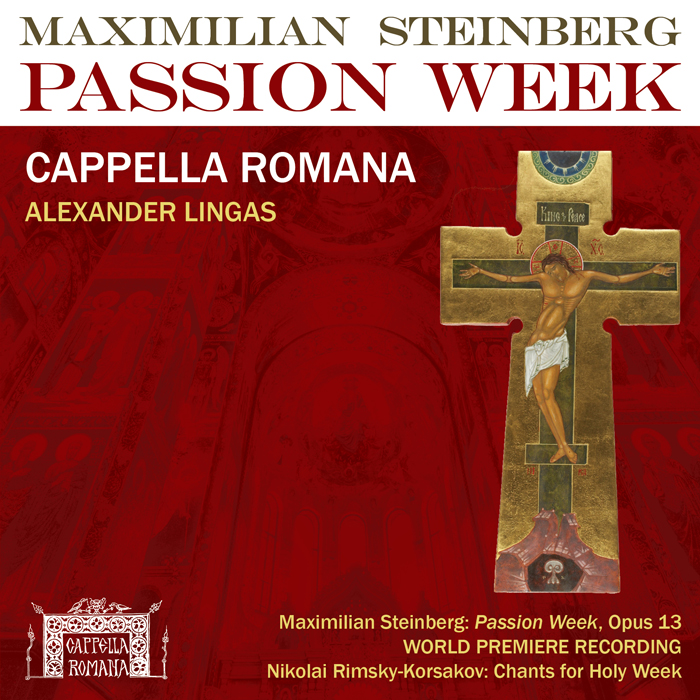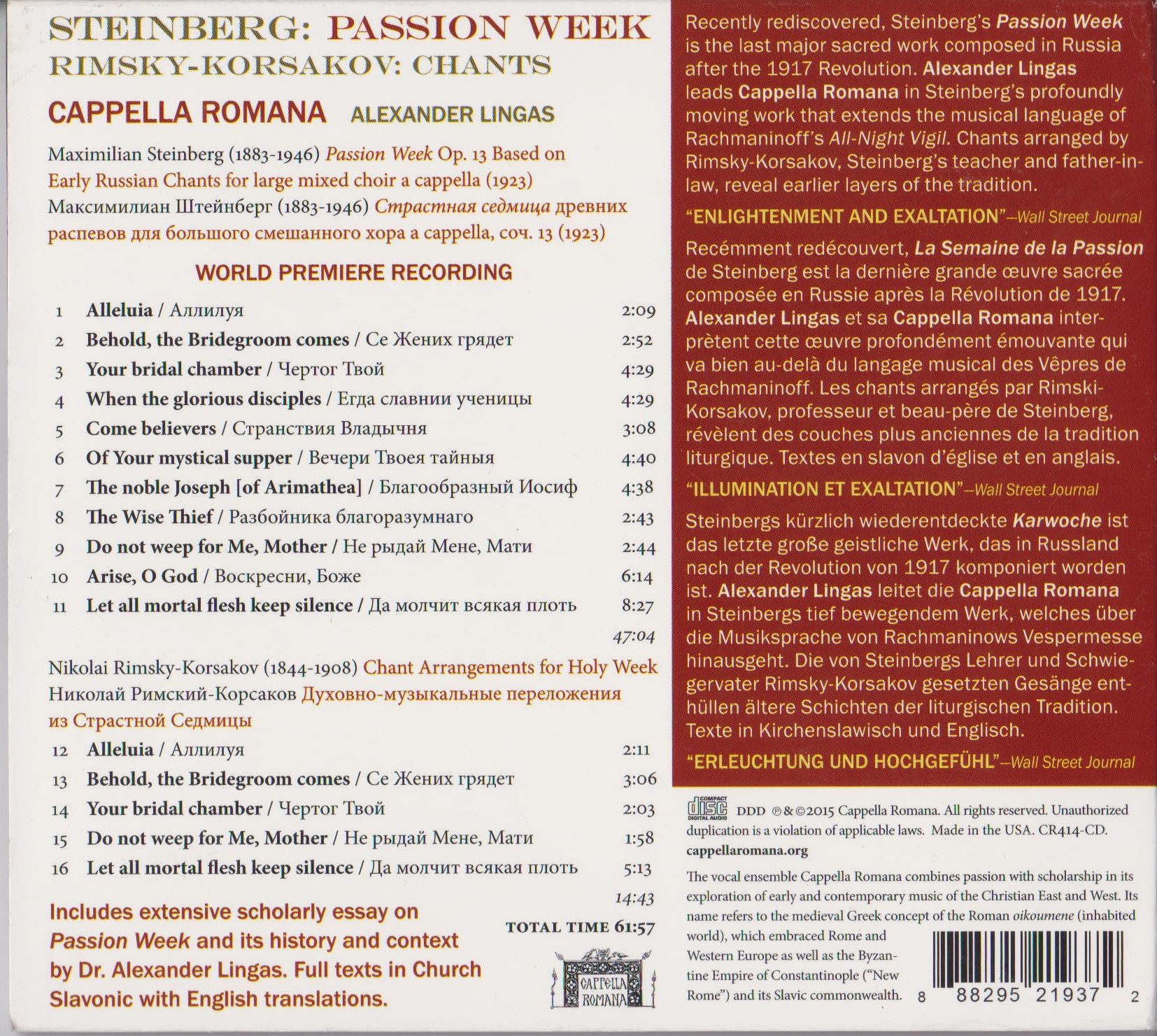Share This
Album at a Glance
Tags
Related Posts
- Fritz Brun: Symphony No. 4; Rhapsody for Orchestra / Moscow Symphony Orchestra; Adriano, conductor
- Metropolitan Hilarion Alfeyev: De Profundis - Compositions for orchestra & choir / Russian Nat’l Orchestra; Moscow Synodal Choir; Alfeyev
- Belyayev Project - Piano trios by Rimsky-Korsakov; Glazunov; Blumenfeld
Maximilian Steinberg (1883-1946): Passion Week, Op. 13; Rimsky-Korsakov: Chants for Holy Week / Cappella Romana; Lingas
Posted by Paul Ballyk on Oct 11, 2015 in Romantic | 0 comments
Of the two works on this recording, the major one, by virtue of the quality of the composition coupled simply with the revelation of its existence, is Passion Week by Lithuanian born Russian composer Maximilian Steinberg (major, too, because the piece takes up three-quarters of the total time of the album, a fact not in and of itself a 'virtue'). This world-premiere recording of Steinberg's sacred masterpiece is rounded out on the album by Rimsky-Korsakov's Chant Arrangements for Holy Week, which dovetails seamlessly at the conclusion of Passion Week, both works sounding to have been cut from the same cassock. The inspired performances are by Cappella Romana on the ensemble's own record label imprint of the same name.
Passion Week is a profoundly moving composition. From the opening, monophonic tones, it is clear that ancient chant is central to the work's structure - in fact, all but one of the eleven sections is based directly on a traditional chant. However, Steinberg's harmonies quickly flower into the rich tonalities and textures that are his legacy of the late Russian Romantic tradition of Rachmaninov, Glazunov and Rimsky-Korsakov. You can listen to the opening two sections of Passion Week, provided as an album sample in the right sidebar of this Expedition Audio page.
The Oregon based vocal ensemble, Cappella Romana, a group founded with the purpose of exploring the musical traditions of the Christian East and West, sound quintessential in this repertoire. This is a unique and beautiful recording, one that deserves to be discovered and loved by many.
On the heels of their chart-topping Good Friday in Jerusalem, Cappella Romana releases its 21st CD, the world premiere recording of Maximilian Steinberg's Passion Week, following their sold-out world premiere live performances of the work in 2014.
Steinberg’s Passion Week is the last major sacred work composed in Russia after the 1917 Revolution. Alexander Lingas leads Cappella Romana’s intrepid singers in Steinberg’s profoundly moving work that extends the musical language of Rachmaninoff ’s All-Night Vigil (“Vespers”). Chants arranged by Rimsky-Korsakov, Steinberg’s teacher and father-in-law, reveal earlier layers of the tradition. Extensive 2,800-word scholarly essay by artistic director Dr. Alexander Lingas (City University London, University of Oxford) included, with full texts in Church Slavonic and translations in English. Cappella Romana is produced since 2004 by GRAMMY™ Award-winner Steve Barnett.
Source: Cappella Romana
|
Maximilian Steinberg |
Maximilian Steinberg, composer Maximilian Osseyevich Steinberg (1883–1946) was a composer of classical music born in Vilnius, Lithuania. Steinberg was born into a Lithuanian Jewish family. His father, Osey (Hosea) Steinberg, was a leading Hebraist. In 1901 he went to Saint Petersburg, to study biology at Saint Petersburg University. He graduated in 1906. In the meantime he also started studying at the Saint Petersburg Conservatory. He entered Anatoly Lyadov’s harmony class, moving on to Nikolai Rimsky-Korsakov’s harmony class and Alexander Glazunov’s counterpoint class. His considerable talent in composition soon showed, encouraged especially by his mentor Rimsky-Korsakov. He graduated from the Conservatory in 1908. Fellow student Igor Stravinsky felt disgruntled at the apparent favor of Steinberg by Rimsky-Korsakov over him. Nevertheless, Steinberg named Stravinsky one of his closest friends when the latter had made a big name in the West, a move Stravinsky strongly resented. Steinberg was considered first as a great hope of Russian music, and was occasionally even more highly estimated than his student colleague, Igor Stravinsky. He rejected Stravinsky’s and other modern styles, usually preferring the style of his teachers and showing the influence of the nationalistic Mighty Handfulas well. His composing technique is handled with firm control and brilliant orchestration - these features have been noticed most often about his compositions. Source: Wikipedia
|
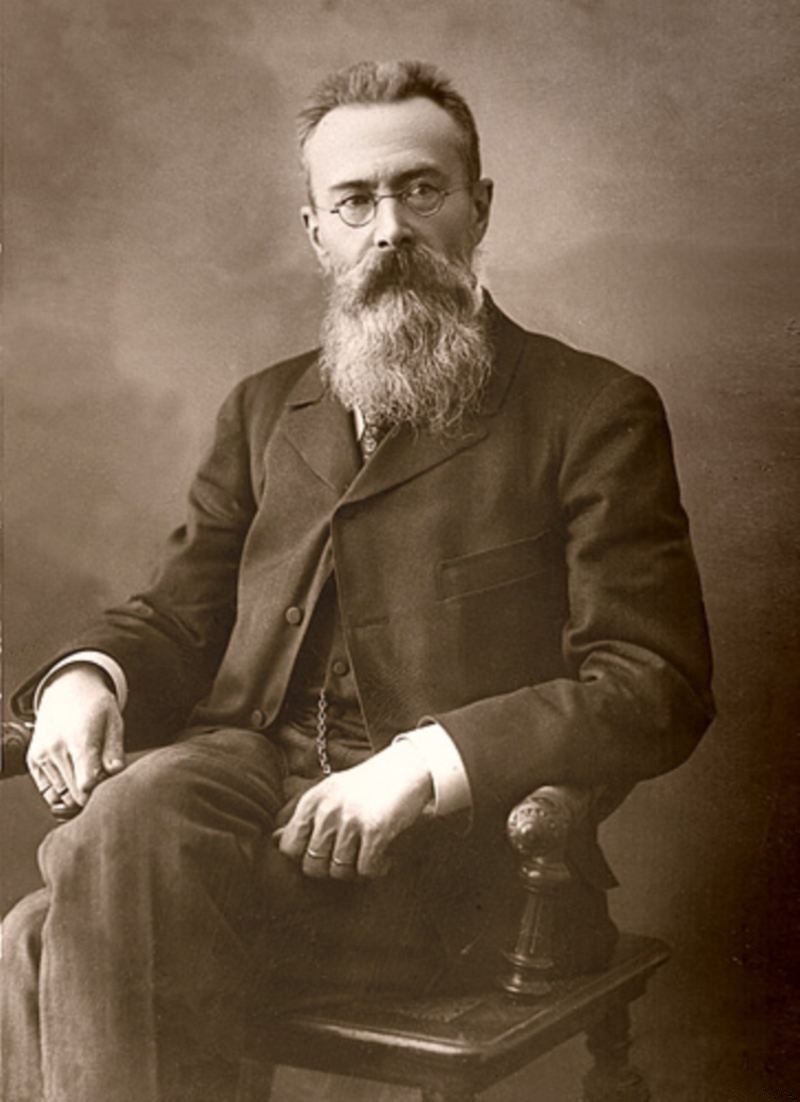 Nikolai Rimsky-Korsakov |
Nikolai Rimsky-Korsakov, composer Nikolai Andreyevich Rimsky-Korsakov (18 March 1844 – 21 June 1908) was a Russian composer, and a member of the group of composers known as The Five. A master of orchestration, his best-known compositions—Capriccio Espagnol, the Russian Easter Festival Overture, and the symphonic suite Scheherazade—are staples of the classical music repertoire, along with suites and excerpts from some of his 15 operas. Scheherazade is an example of his frequent use of fairy tale and folk subjects. Rimsky-Korsakov believed, as did fellow composer Mily Balakirev and critic Vladimir Stasov, in developing a nationalistic style of classical music. This style employed Russian folk song and lore along with exotic harmonic, melodic and rhythmic elements in a practice known as musical orientalism, and eschewed traditional Western compositional methods. However, Rimsky-Korsakov appreciated Western musical techniques after he became a professor of musical composition, harmony and orchestration at the Saint Petersburg Conservatory in 1871. He undertook a rigorous three-year program of self-education and became a master of Western methods, incorporating them alongside the influences of Mikhail Glinka and fellow members of The Five. His techniques of composition and orchestration were further enriched by his exposure to the works of Richard Wagner. Rimsky-Korsakov left a considerable body of original Russian nationalist compositions. He prepared works by The Five for performance, which brought them into the active classical repertoire (although there is controversy over his editing of the works of Modest Mussorgsky), and shaped a generation of younger composers and musicians during his decades as an educator. Rimsky-Korsakov is therefore considered “the main architect” of what the classical music public considers the Russian style of composition. His influence on younger composers was especially important, as he served as a transitional figure between the autodidactism which exemplified Glinka and The Five and professionally trained composers which would become the norm in Russia by the closing years of the 19th century. While Rimsky-Korsakov’s style was based on those of Glinka, Balakirev, Hector Berlioz, and Franz Liszt, he “transmitted this style directly to two generations of Russian composers” and influenced non-Russian composers including Maurice Ravel, Claude Debussy, Paul Dukas and Ottorino Respighi. Source: Wikipedia |
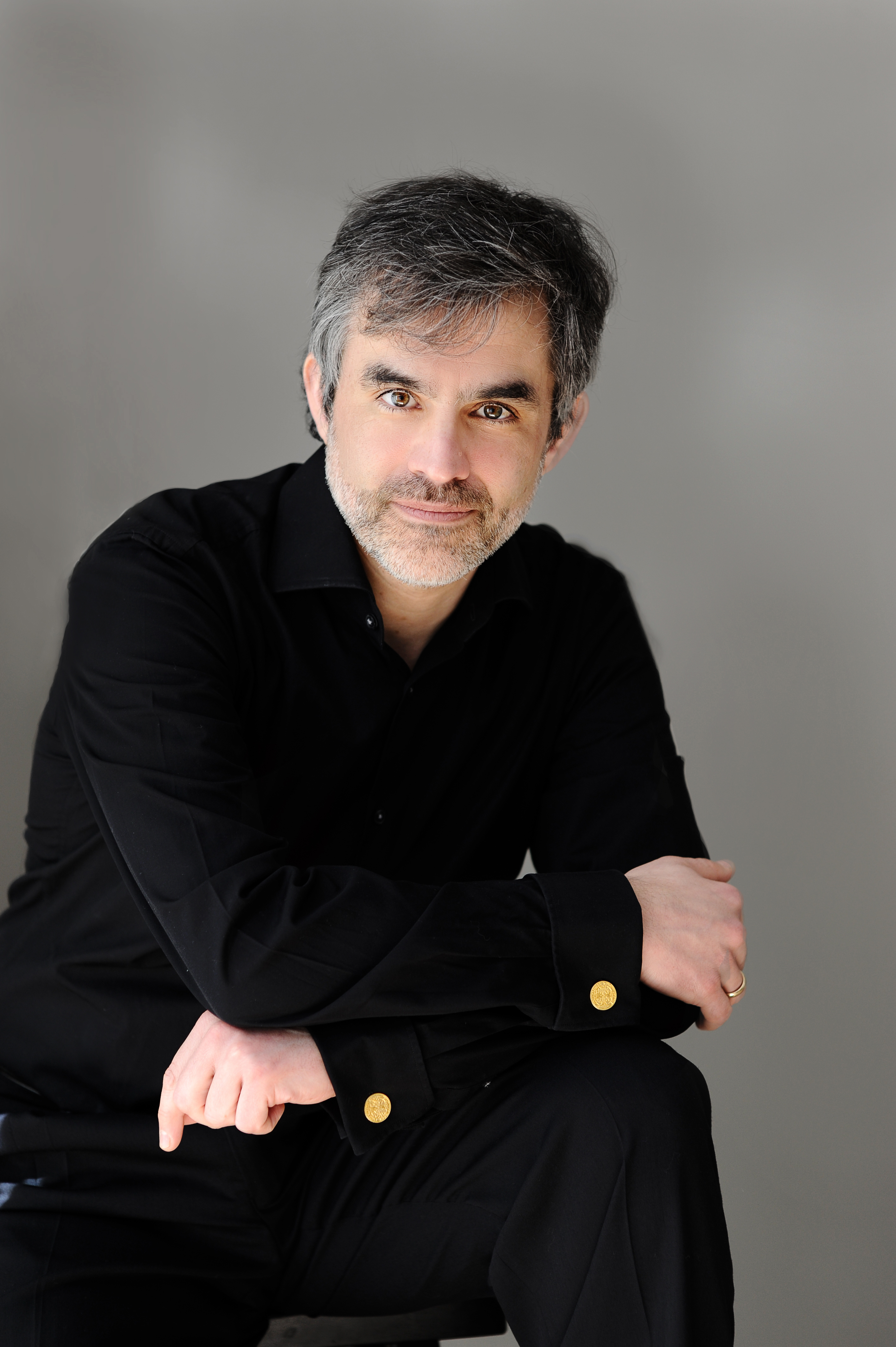 Alexander Lingas |
Alexander Lingas, conductor Dr. Alexander Lingas is the founder and Artistic Director of the vocal ensemble Cappella Romana and a Fellow of the University of Oxford’s European Humanities Research Centre. His present work embraces historical study, ethnography, and performance. Formerly Assistant Professor of Music History at Arizona State University’s School of Music, he received his Ph.D. in Historical Musicology from the University of British Columbia. His academic awards include Fulbright and Onassis grants for musical studies with cantor Lycourgos Angelopoulos, a Canadian postdoctoral fellowship for study under Metropolitan Kallistos (Ware) of Diokleia, and a British Academy Postdoctoral Research Fellowship held at St Peter’s College, Oxford. His publications include articles for The Oxford Companion to Music, The New Grove Dictionary of Music and Musicians, and The Oxford Handbook of Byzantine Studies. He is currently working on a study of Sunday Matins in the Rite of Hagia Sophia for Ashgate and a historical introduction to Byzantine Chant for Yale University Press. Since founding Cappella Romana in 1991, Dr Lingas has appeared with the ensemble at the Metropolitan Museum of Art in New York, the J Paul Getty Museum, the Pontificio Istituto Orientale in Rome, the Irish World Music Centre in Limerick, Princeton University, and Yale University. Cappella Romana has been featured on twelve compact discs, including Byzantium 330-1453 (the official companion CD to the Royal Academy of Arts Exhibition). Forthcoming recordings include a disc of 15th-century Byzantine and Latin music from Cyprus. |
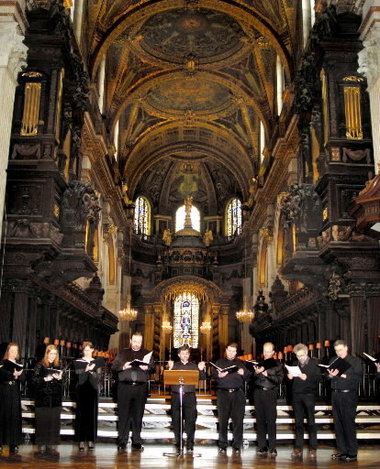 Cappella Romana |
Cappella Romana, ensemble Cappella Romana is a professional vocal ensemble that performs early and contemporary sacred classical music in the Christian traditions of East and West. The ensemble is known especially for its presentations and recordings of medieval Byzantine chant (the Eastern sibling of Gregorian chant), Greek and Russian Orthodox choral works, and other sacred music that expresses the historic traditions of a unified Christian inheritance. Cappella Romana brings to life music that meets a deep human need, not only to belong and to have a shared creative experience, but to feel the full range of ethical, emotional, and spiritual effect as expressed through music. We strive to give an experience that allows you, our audience, to feel a sheer joy that cannot be contained by mere words, but through the ineffable sounds of the human voice in song. Source: Artist website |
![]() About Paul Ballyk
About Paul Ballyk
all about Paul
Twitter •
| Thinking about purchasing this album?
Follow this link for more album details or to make the purchase. Buy it now |
“Not just recommended. Guaranteed.”
We stand behind every album featured on Expedition Audio. Our objective is to take the monetary risk out of music exploration. If you order this album from HBDirect.com and do not like it you can return it for a refund.
More Listening: Steinberg - Symphony No. 1





